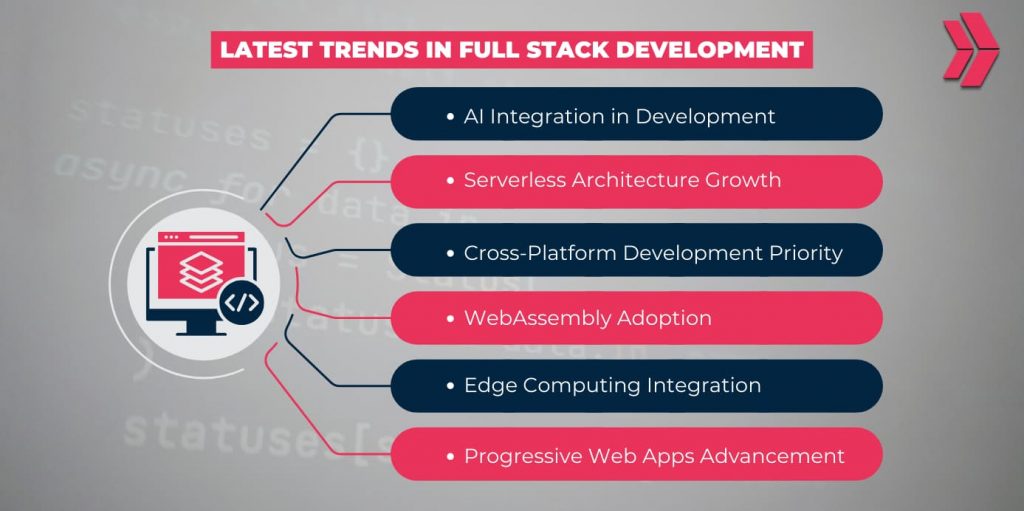The tech industry is evolving rapidly, with AI-driven companies seeing up to 40% productivity gains according to McKinsey research. As professionals ask “is full stack web development still in demand 2025”, the data shows a clear trend: to thrive in this changing landscape, professionals must learn and adapt to the latest trends shaping full stack development. Understanding the skills required for the future is crucial, as the U.S. Bureau of Labor Statistics projects 13% growth in web developer jobs through 2030. With JavaScript maintaining its dominance at 62% popularity among developers in Stack Overflow’s 2024 survey, comprehensive full stack development training has become essential for staying competitive.
In this article, we explore how developers and organizations can prepare for the future by focusing on emerging technologies and evolving workflows, as demonstrated by leading companies achieving up to 30% efficiency improvements through AI integration.

What are the Latest Trends in Full Stack Development?
Here are the latest trends in full-stack development:
- AI Integration in Development
- Serverless Architecture Growth
- Cross-Platform Development Priority
- WebAssembly Adoption
- Edge Computing Integration
- Progressive Web Apps (PWA) Advancement

AI Integration in Development
AI tools will become essential for full stack developers. Developers will use:
- Code generation tools to write basic components and boilerplate code
- AI debugging assistants to find and fix errors faster
- Automated testing systems to create comprehensive test suites
- Smart code completion that understands project context
Serverless Architecture Growth
Serverless computing will expand in full stack development. Benefits include:
- Lower infrastructure costs
- Automatic scaling based on demand
- Reduced server maintenance work
- Faster deployment cycles
Cross-Platform Development Priority
The demand for cross-platform applications will increase. Developers must:
- Build applications that work on multiple devices
- Use frameworks that support various platforms
- Create consistent user experiences across devices
- Optimize performance for different screen sizes
WebAssembly Adoption
WebAssembly will enable high-performance web applications. Advantages include:
- Near-native application speed
- Support for multiple programming languages
- Better browser compatibility
- Enhanced security features
Edge Computing Integration
Edge computing will become central to full stack development. Changes include:
- Faster data processing at network edges
- Reduced latency for users
- Better real-time application performance
- Improved data privacy compliance
Progressive Web Apps (PWA) Advancement
Progressive Web Apps (PWAs) will gain more importance in full stack development. Their benefits include:
- Offline Functionality: PWAs allow users to access content even without an internet connection.
- App-Like Experience: They combine the feel of a native app with the accessibility of a website.
- Improved Performance: PWAs load faster and provide seamless user experiences.
- Platform Independence: Developers can create a single PWA that works on all devices and operating systems.
- Lower Development Costs: A unified codebase reduces the time and cost needed for development and maintenance.
What are the Required Skills for Future Developers?
Full stack developers will need these skills:
- AI and machine learning basics
- Cloud service management
- Security best practices
- Performance optimization techniques
- API design and integration
- Cross-platform development expertise

Developers who learn these technologies will have many job opportunities, as they enhance their full stack developer skills.
How will the Development Process Change?
The development process will shift to include:
- More automated testing and deployment
- Integration of AI throughout development
- Enhanced security measures
- Faster release cycles
- Better collaboration tools
These changes will streamline workflows and improve efficiency in full stack development.
Is Full Stack Web Development Still in Demand 2025?
Yes, full stack web development remains highly in demand in 2025. As businesses continue to prioritize digital transformation, the need for versatile developers who can handle both front-end and back-end tasks has grown. According to recent industry reports, companies prefer full stack developers for their ability to manage entire projects efficiently, reducing the need for larger teams. Moreover, the rise of emerging technologies like AI, cloud computing, and edge computing has further highlighted the importance of developers with diverse skill sets. The U.S. Bureau of Labor Statistics’ projection of 13% growth in web development jobs by 2030 underscores the steady demand for these roles. In 2024, full stack development training is a critical step for anyone aiming to secure a future in this dynamic field.
Conclusion
Full stack development is changing rapidly with new technologies. Developers who learn these skills will succeed in this field. Companies should prepare for these changes by updating their development practices and training their teams. Investing in these skills is essential for anyone seeking comprehensive full stack development training.




